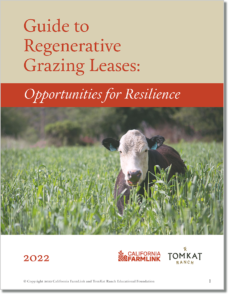As part of TomKat Ranch’s broader effort to develop a toolkit to support the transition to and expansion of regenerative agriculture, we teamed up with California FarmLink to publish
Guide to Regenerative Grazing Leases: Opportunities for Resilience

03/30/2022
As part of TomKat Ranch’s broader effort to develop a toolkit to support the transition to and expansion of regenerative agriculture, we teamed up with California FarmLink to publish an extensive new resource for landowners and the grazing community: Guide to Regenerative Grazing Leases: Opportunities for Resilience.
 Across the US today, nearly 30% of grazing land is leased. Typical leases rarely recognize or incentivize standards for caring for these lands. Over time, lack of long-term investment and ecological management of rangelands can lead to costly declines in soil health, biodiversity, and productivity—affecting landowners, lessees, and the human and wild communities that depend upon these ecosystems.
Across the US today, nearly 30% of grazing land is leased. Typical leases rarely recognize or incentivize standards for caring for these lands. Over time, lack of long-term investment and ecological management of rangelands can lead to costly declines in soil health, biodiversity, and productivity—affecting landowners, lessees, and the human and wild communities that depend upon these ecosystems.
The guide provides a framework for drafting rigorous grazing leases that articulate shared agricultural, ecological, and social values. Designed with the needs of graziers, private landowners, public agencies, and land trusts in mind, the guide illustrates how land leases can serve broader purposes. It helps readers design and maintain regenerative grazing leases to support resilience, adaptability, and economic opportunity in rural communities.
The guide includes detailed guidance on many topics, including:
- Writing, Negotiating and Maintaining the Lease
- Rent and Rent Payments
- Communication and Dispute Resolution
- Creating an Agricultural Management Plan (AMP)
- Acknowledging Land and Power
- Passing Down the Ranch
Effective communication is vital to support adaptive rangeland management and help align incentives around productivity and resilience. “People using this guide will be able to create leases that help to improve biodiversity, soil health, water infiltration capacity, and water quality. Regenerative grazing leases can help meet these ecological goals, while also furthering a rancher’s business and greater community goals,” stated Kendra Johnson, FarmLink program advisor and author of the guidebook.
It is more important than ever that we support and facilitate relationships between landholders and land stewards to turn these opportunities for resilience into transformative change on the land and in our communities. “We see such a need in the world for tools and models that support landowners who want to get into this kind of work. We do this work [at TomKat Ranch] because this is the way we’re going to be able to create a different kind of food system and keep everything on this planet—people, animals, soil, air, and water—all healthy,” says TomKat Ranch Director Wendy Millet.
Thank you to the many advisors who spoke with us and offered their valuable insights for this guidebook, and to the land stewards practicing regeneration now and into the future.
The guidebook’s sixty-four pages contain dozens of resources and references for charting a new future on California rangelands. The publication is available here.
The full interview with TomKat Ranch Director, Wendy Millet, Ranch Manager, Mark Biaggi, and FarmLink Program Advisor, Kendra Johnson, is available here.
TomKat Ranch’s growing Regenerative Ranching Toolkit, including the Guide to Regenerative Grazing Leases, is available here.
***
California FarmLink is a nonprofit organization working across California with a mission to invest in the prosperity of farmers and ranchers through lending, education, and access to land.